Birds are a fascinating and essential part of the coastal environment. They are found in nearly every coastal habitat, from rocky shores and sandy beaches to marshy wetlands and the open ocean.
Coastlines provide birds with various food sources, and many rely on these habitats for survival. From seabirds to shorebirds, waterfowl, and songbirds, the array of bird species in the coastal environment is vast and impressive.
The Coast is fabulous for birdwatchers to observe birds in their natural habitats. It is also essential to protecting bird populations, as many species are threatened by human activity.
By understanding and appreciating the value of birds in the coastal environment, we can work together to ensure their future.
47 Birds to Watch in Coast
If you love birdwatching, you’ll be delighted by the variety and beauty of the birds found along the Coast. Whether visiting the beach, the cliffs, or the marshes, you’ll have plenty of opportunities to observe and admire these feathered creatures.
Here are 47 birds that you should watch out for when you’re exploring the coastal habitats.
1. Oystercatchers
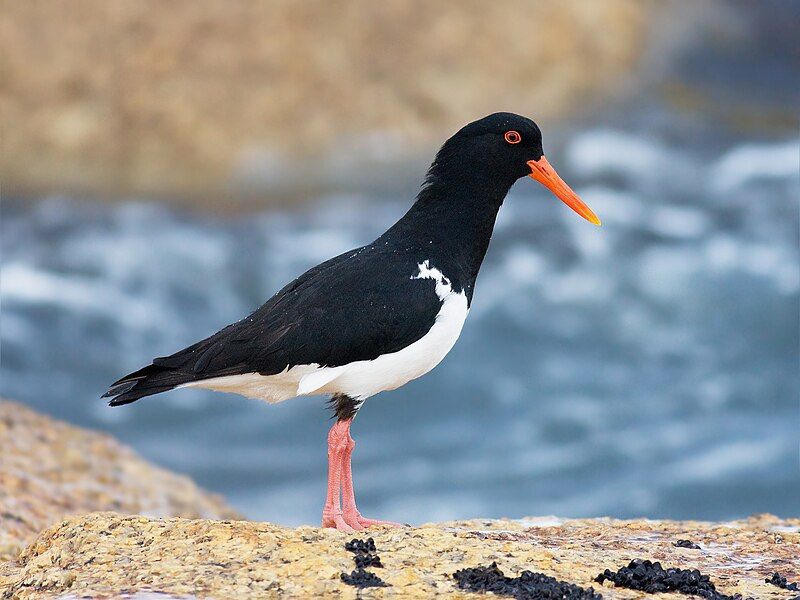
The oystercatchers are a type of bird found in wading environments. They belong to the family Haematopodidae, with only one genus, Haematopus.
Oystercatchers can be found worldwide, except for the polar regions and some tropical regions of Africa and South East Asia. They are found in coastal and marine habitats, as they feed on mollusks, crustaceans, and aquatic worms found in these areas.
Oystercatchers have long, bright orange beaks to catch their food. They also have long legs, which help them wade through shallow waters for food.
The plumage of these birds is usually black and white, though some species have brown and grey feathers.
| Kingdom | Animalia |
| Phylum | Chordata |
| Class | Aves |
| Order | Charadriiformes |
| Family | Haematopodidae |
| Genus | Haematopus |
2. Sanderling
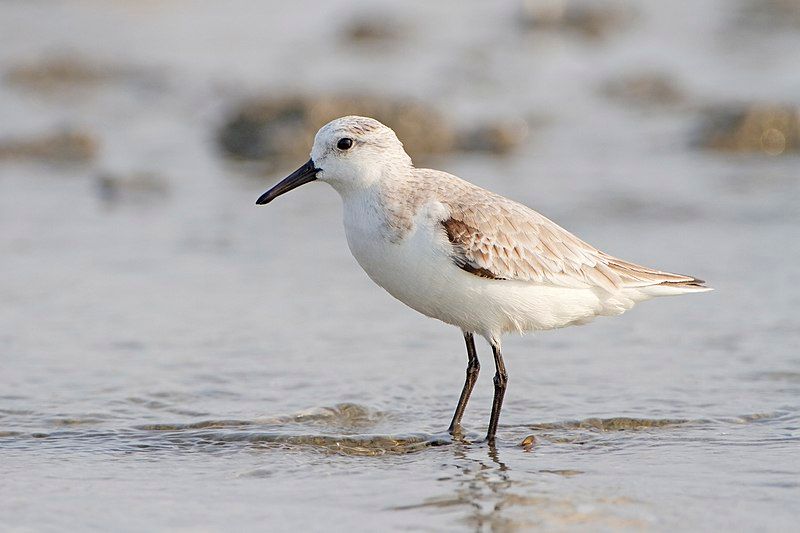
The sanderling is a small wading bird that gets its name from Old English. The word sand-yrðling describes a person who plows the sand.
The genus name of the sanderling, kalidris or skalidris, is derived from Ancient Greek and was used by Aristotle to refer to certain grey-colored water birds. The species name, alba, is Latin for ‘white,’ an apt descriptor of the sanderling’s color.
This bird can be found in coastal habitats, where it uses its long legs to quickly move through the sand, searching for small crustaceans and insects to feed on. It can also be found in inland habitats during the non-breeding season.
The sanderling is an integral part of the ecosystem, providing food for other animals like foxes and owls and helping shoreline habitats.
| Kingdom | Animalia |
| Phylum | Chordata |
| Class | Aves |
| Order | Charadriiformes |
| Family | Scolopacidae |
| Genus | Calidris |
| Species | C. alba |
3. Sternidae
Terns are a type of seabird that can be found all over the world in various habitats. They are a subgroup of the family Laridae, which also includes gulls and skimmers. This family is made up of eleven different genera, all of which are seen near the sea, rivers, or wetlands.
Terns are often seen gliding on the wind above the water, hunting for small fish and other food. They are typically small, with grey and white feathers and long, pointed wings. They have a distinctive forked tail that helps them to turn quickly and sharply in the air.
Terns are highly social birds, often seen in large flocks, and can travel great distances for food. They are also known for their elaborate courtship displays, which involve calling, bowing, and gift-giving.
| Kingdom | Animalia |
| Phylum | Chordata |
| Class | Aves |
| Order | Charadriiformes |
| Family | Laridae |
4. Cormorants
Phalacrocoracidae is a family of aquatic birds in various parts of the world, including Europe, Asia, and Africa. These birds are commonly referred to as cormorants and shags.
Scientists have long debated the exact classification of this family, and in 2021, the International Ornithologists’ Union (IOU) finally reached a consensus on seven genera.
These seven genera represent the various species of Phalacrocoracidae that can be found worldwide. The seven genera are Microcarbo, Leucocarbo, Phalacrocorax, Nannopterum, Hydrocorax, Leucocarbo, and Onychoprion.
Each genus has a variety of species, many of which are found in different parts of the world.
For example, the genus Microcarbo includes species such as the Little Cormorant (Microcarbo niger) and the Great Cormorant (Microcarbo capensis), which are both found in Europe and Asia.
Similarly, the genus Phalacrocorax includes species such as the Great Cormorant (Phalacrocorax carbo) and the Reed Cormorant (Phalacrocorax africanus) found in Africa.
The classification of the family Phalacrocoracidae has been debated for years. Still, with the adoption of the consensus taxonomy in 2021, the IOU has provided a comprehensive and widely accepted classification of these birds.
This classification can help scientists and bird enthusiasts better understand and appreciate the diversity of these aquatic birds.
| Kingdom | Animalia |
| Phylum | Chordata |
| Class | Aves |
| Order | Suliformes |
| Family | Phalacrocoracidae |
5. Puffins
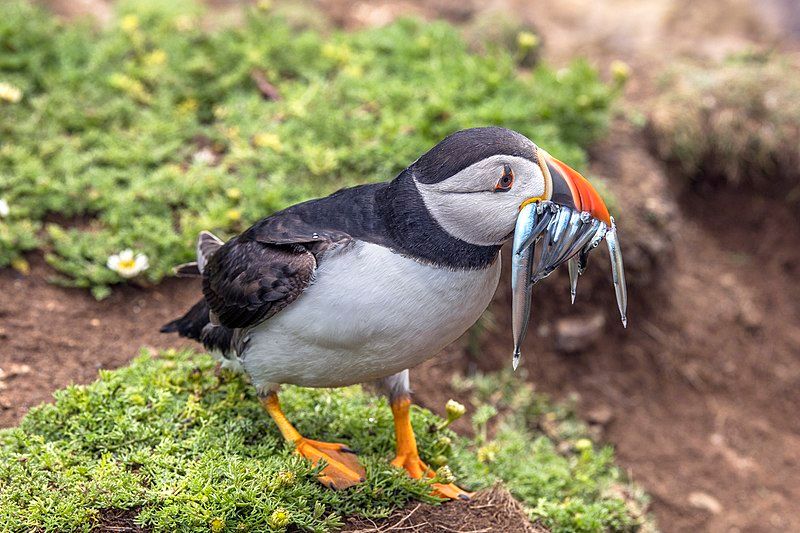
Puffins are members of the Alcidae family, which includes auks, murres, and guillemots. They are found in the Northern Hemisphere and can be identified by their brightly colored bills and distinctive black and white plumage.
Puffins typically feed by diving into the water to catch fish, squid, and other small aquatic creatures. They breed in large colonies, nesting in crevices among cliff rocks or burrows in the soil. These colonies are generally located on the Coast or offshore islands.
Puffins are social birds, and their colonies are often quite noisy due to their loud calls. They are also monogamous and form long-term partnerships with their mates.
Puffins are an essential part of the marine ecosystem, as they help to control fish populations by preying on them and transporting nutrients throughout the ocean. They are also popular with birdwatchers and other nature enthusiasts.
| Kingdom | Animalia |
| Phylum | Chordata |
| Class | Aves |
| Order | Charadriiformes |
| Family | Alcidae |
| Genus | Fratercula |
6. Willet
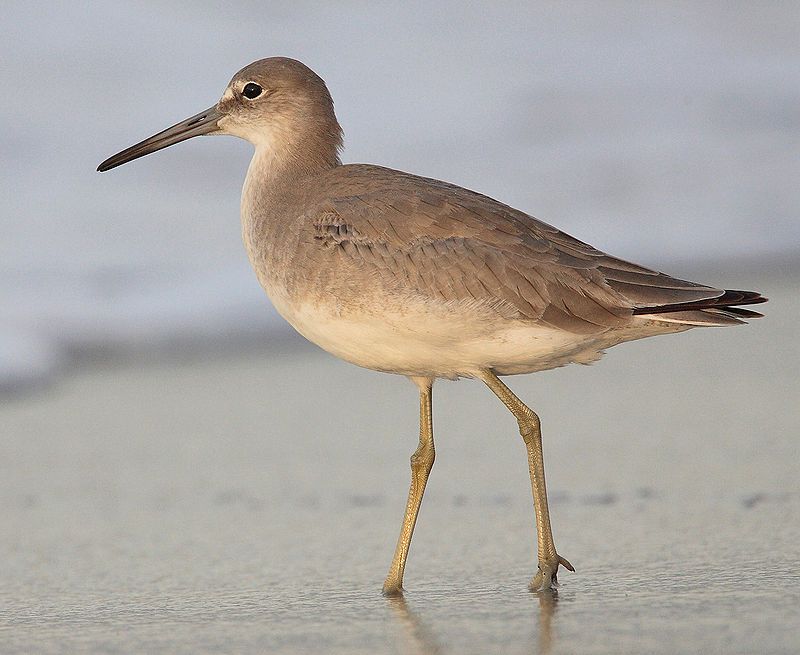
The willet is a species of large shorebird belonging to the Scolopacidae family. It is a stocky sandpiper, significantly larger than most other species in the genus Tringa, commonly known as shanks. It has a roughly 75-90 cm wingspan with a length of approximately 35-45 cm.
Its plumage is primarily grey or brown, with a white underside and a distinctive black-and-white wing pattern. The willet is an omnivore, and its diet includes insects, worms, crustaceans, and mollusks.
It is commonly found on beaches, mudflats, and marshes and is known for its loud, distinctive call. Willets are migratory and can be found across much of North America and parts of Europe and Asia.
| Kingdom | Animalia |
| Phylum | Chordata |
| Class | Aves |
| Order | Charadriiformes |
| Family | Scolopacidae |
| Genus | Tringa |
| Species | T. semipalmata |
7. Brown Pelican
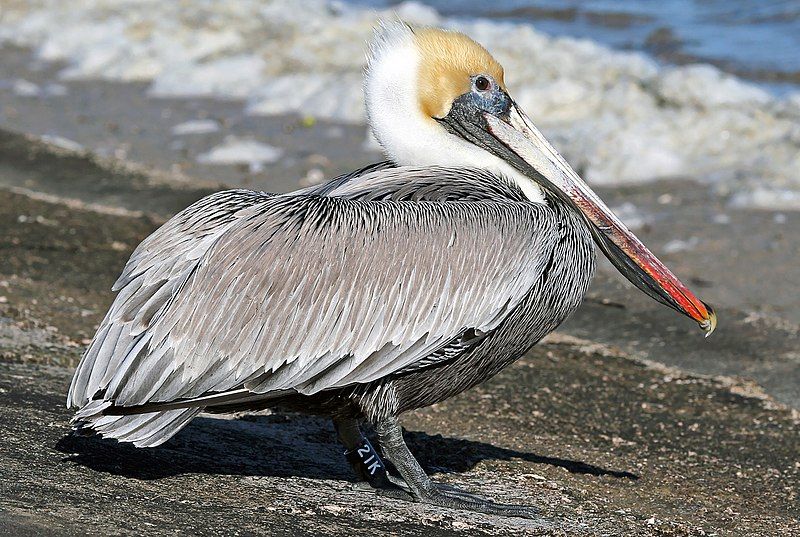
The brown pelican is a large seabird that belongs to the Pelecanidae family. It is one of three pelicans living in the Americas and one of two feeding by diving into the water.
These birds have a unique way of catching their prey; they plunge into the water from a great height, using their large beak to scoop up fish. They can also skim the water’s surface with their beak, which helps them catch small prey.
The brown pelican is a social bird, living in large colonies near the Coast and usually nesting in trees or islands. They have a distinctive brownish-gray body, white head and neck, and long curved beak.
They are also notable for their large wingspan, reaching up to seven feet. The brown pelican is an important species, as it helps maintain a healthy marine ecosystem by controlling the small fish population.
| Kingdom | Animalia |
| Phylum | Chordata |
| Class | Aves |
| Order | Pelecaniformes |
| Family | Pelecanidae |
| Genus | Pelecanus |
| Species | P. occidentalis |
8. Ruddy Turnstone
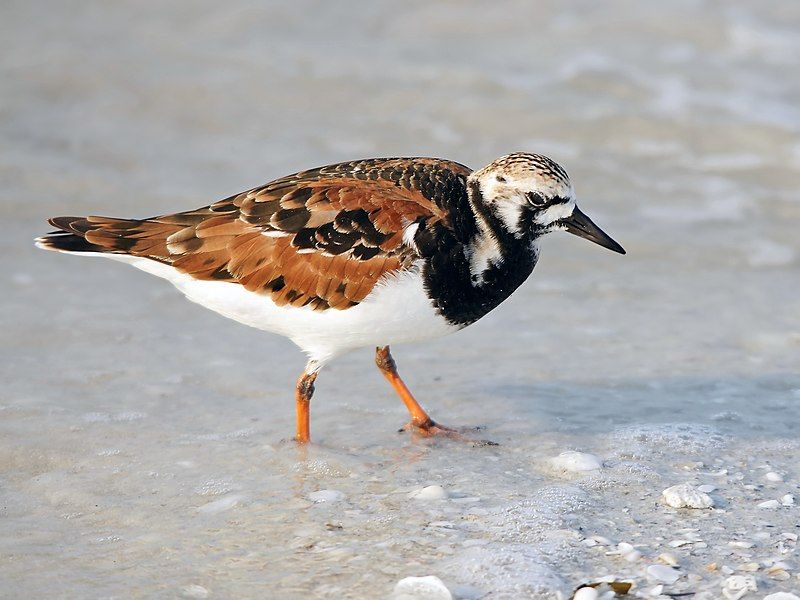
The ruddy turnstone is a small bird found all around the world. It belongs to the genus Arenaria and is part of the sandpiper family Scolopacidae. This bird was previously considered to be part of the plover family Charadriidae.
A wading bird searches for food in shallow water and wet areas. The ruddy turnstone is one of two species of turnstone, the other being the black turnstone.
Both species have reddish-brown upperparts, white underparts, and a black head and neck. They can be distinguished by their bill, which is short and slightly down-curved in the ruddy turnstone compared to the black turnstone’s longer and more pointed bill.
| Kingdom | Animalia |
| Phylum | Chordata |
| Class | Aves |
| Order | Charadriiformes |
| Family | Scolopacidae |
| Genus | Arenaria |
| Species | A. interpres |
9. Common Murre
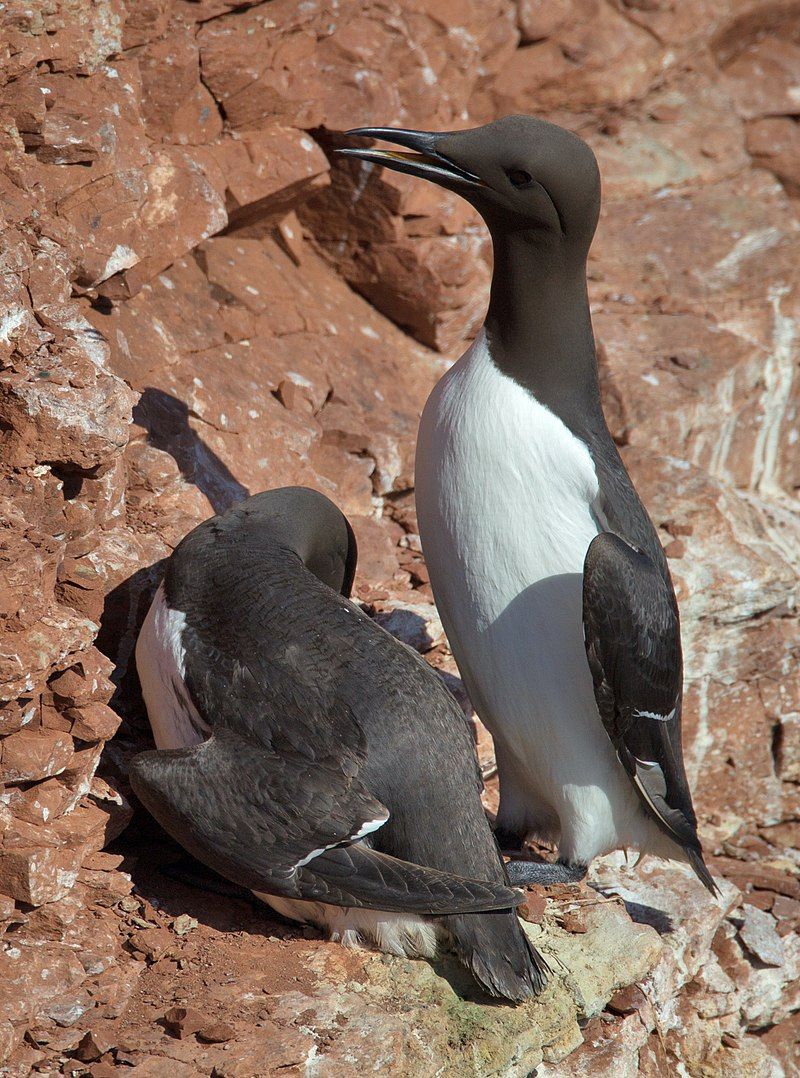
Like the guillemot, the common mirrort is a type of auk found around the North Atlantic and North Pacific regions in low-Arctic and boreal waters.
These birds spend most of their time at sea, only coming to land to nest and breed on rocky cliffs or islands. The common murre has a circumpolar distribution, meaning that it can be found in multiple regions, all the way around the Earth’s poles.
This bird is a large auk, and its size contributes to its impressive ability to thrive in various aquatic habitats. It is well-suited for life in the air and at sea, with its long wings and streamlined body allowing the bird to swim and fly quickly.
Because the ordinary murre cane in a wide range of environments and habitats, it is a species that can thrive in many different areas.
| Kingdom | Animalia |
| Phylum | Chordata |
| Class | Aves |
| Order | Charadriiformes |
| Family | Alcidae |
| Genus | Uria |
| Species | U. aalge |
10. Auk
The Alcidae family is an order of birds typically found in the Charadriiformes order. They are also known as auks and are closely related to the penguin family. Twenty-five extant species of these birds are divided into 11 genera.
These species can be found in different parts of the world, including murres, guillemots, auklets, puffins, and murrelets. Murres are a species of seabird that is closely related to guillemots.
They are usually black or dark brown, with a thin white line running along the side of their body.
Murres are known for their diving abilities, and their diet consists mainly of fish and squid. Guillemots are large, black and white birds in the North Atlantic Ocean. They feed by diving, consisting of fish, crustaceans, and mollusks.
Guillemots are known for their ability to fly long distances and breed on rocky cliffs. Auklets are small, black and white birds in the North Pacific Ocean. They feed primarily on plankton and are known for their highly vocal calls.
Auklets are also known for their unique courtship and breeding behavior. Puffins are a seabird species found mainly in the Northern Hemisphere. They are black and white with a distinctive orange bill.
Puffins feed mainly on fish and are known for their ability to dive underwater to catch their prey. Finally, murrelets are small seabirds found primarily in the North Pacific Ocean. They are black and white and feed mainly on fish and crustaceans.
Murrelets are also known for their ability to dive underwater to catch their prey. Overall, the Alcidae family includes a wide variety of species that can be found around the world. They are known for their diving abilities, unique diets, and behaviors.
| Kingdom | Animalia |
| Phylum | Chordata |
| Class | Aves |
| Order | Charadriiformes |
| Family | Alcidae |
11. Double-crested Cormorant
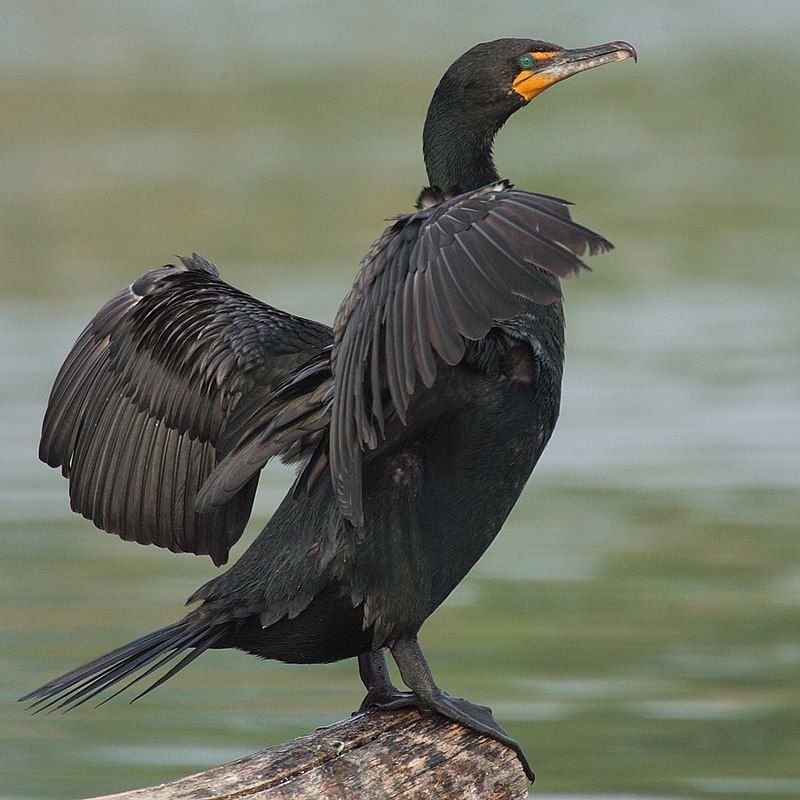
The double-crested cormorant is a water bird species belonging to the cormorant family. This bird species is found near bodies of water, such as rivers, lakes, and coastal areas.
It is a prevalent species found in many areas of North America, from the Aleutian Islands in Alaska to the southern tip of Florida and Mexico.
This species of cormorant is very adaptable and can be found in numerous habitats, from inland wetlands to coastal estuaries.
It is also known to travel great distances, as far as Mexico and the Caribbean. The double-crested cormorant has a unique appearance with its black body, long neck, and hooked bill. It is a medium-sized bird with an average body length of 28 and 35 inches.
It has a pair of distinctive crests on its head, which are usually more prominent during the breeding season. As a water bird, the double-crested cormorant is an excellent swimmer. Its webbed feet and dense feathers let it move quickly and gracefully through the water.
It is also a skilled hunter, preying on fish and crustaceans. The double-crested cormorant is an important species for many North American ecosystems. It helps keep aquatic populations in check while providing food for other animals.
It is also a famous bird for birdwatchers, often seen near the shoreline or perched atop a tree or rock.
| Kingdom | Animalia |
| Phylum | Chordata |
| Class | Aves |
| Order | Suliformes |
| Family | Phalacrocoracidae |
| Genus | Nannopterum |
| Species | N. auritum |
12. Curlews
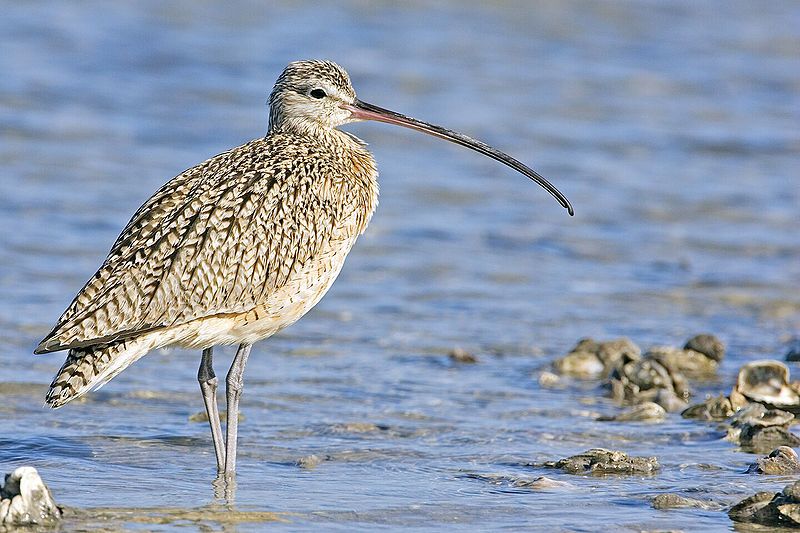
The curlew is a group of nine species of birds in the genus Numenius. These birds are distinguished by their long, curved beaks and mottled brown plumage.
The English name of the bird is based on the call of the Eurasian curlew but may also have been influenced by the Old French word “cool,” which means “messenger” and is derived from the verb “courier,” meaning “to run.”
The curlew is a migratory bird, traveling long distances to different locations for food. These birds are found in many parts of the world, including North America, Europe, and Asia.
They are typically found in grasslands, marshes, wet meadows, and coastal areas. The curlew is an essential bird in many cultures and has been featured in literature, art, and music. The bird’s distinctive call is often used to symbolize solitude and nature.
Some believe that the ancient Celts associated the curlew with the goddess of the land and linked their call to the coming of spring. The curlew plays an essential role in the environment, as it helps keep the food chain balanced by preying on insects and small mammals.
They also help to aerate the soil by digging for food, and their droppings are a valuable source of nutrients for the soil. Overall, the curlew is a unique and important species of bird.
It symbolizes nature, solitude, and the transition of the seasons and plays a vital role in the balance of the environment.
| Kingdom | Animalia |
| Phylum | Chordata |
| Class | Aves |
| Order | Charadriiformes |
| Family | Scolopacidae |
| Genus | Numenius |
13. Grey Plover
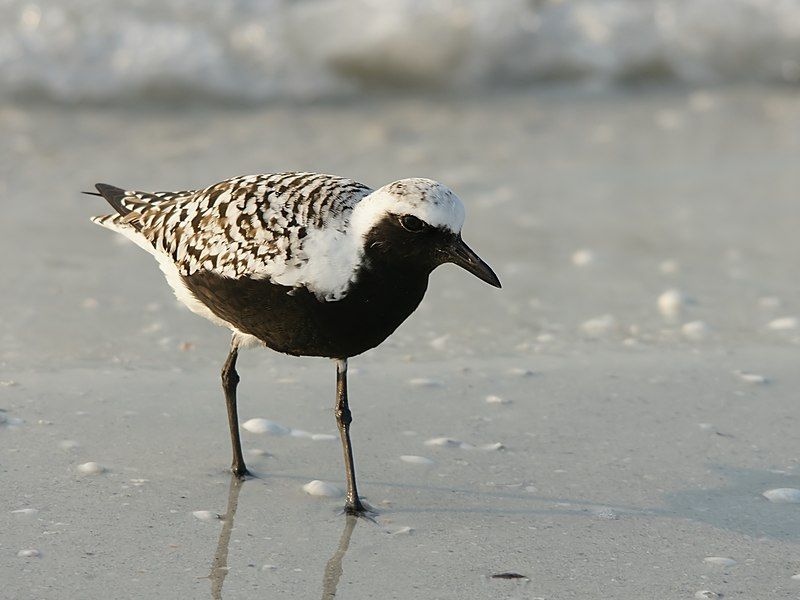
The Grey Plover, also known as the Black-bellied Plover in North America, is a sizeable cosmopolitan plover species. This species is found in many Arctic regions, breeds, and nests.
It is a migratory species and can be found in a variety of coastal regions all over the world when it is not breeding. This species has a mainly coastal habitat and is often found near the shorelines of continents, islands, and other coastal regions.
The Grey Plover is an important species for many coastal environments and is a crucial part of the food web in many of these areas. It is also an important species for many birdwatchers, as it is one of the few plover species to migrate long distances.
| Kingdom | Animalia |
| Phylum | Chordata |
| Class | Aves |
| Order | Charadriiformes |
| Family | Charadriidae |
| Genus | Pluvialis |
| Species | P. squatarola |
14. Pectoral Sandpiper
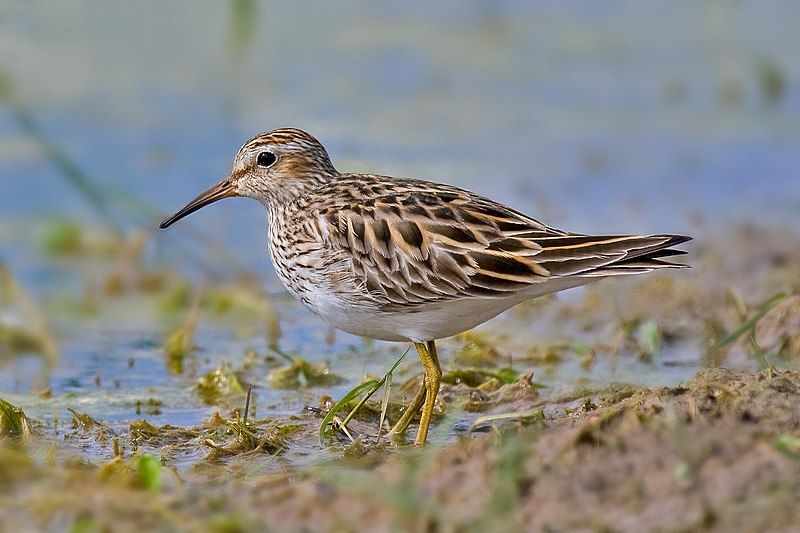
The pectoral sandpiper is a small bird that migrates to America and Asia in the summer and South America and Oceania in the winter.
It primarily feeds on small invertebrates, such as insects and larvae, making it an essential predator in the food chain. During the breeding season, the pectoral sandpiper builds a nest in the ground.
This nest is a hollowed-out hole with a thick lining and is designed to protect the four eggs laid by the female from the cold breezes common in the sandpiper’s breeding grounds. The nest is also deep enough to provide some insulation from the freezing temperatures.
This nesting strategy helps to ensure the survival of the sandpiper’s eggs and helps the species to thrive.
| Kingdom | Animalia |
| Phylum | Chordata |
| Class | Aves |
| Order | Charadriiformes |
| Family | Scolopacidae |
| Genus | Calidris |
| Species | C. melanotos |
15. Arctic Tern
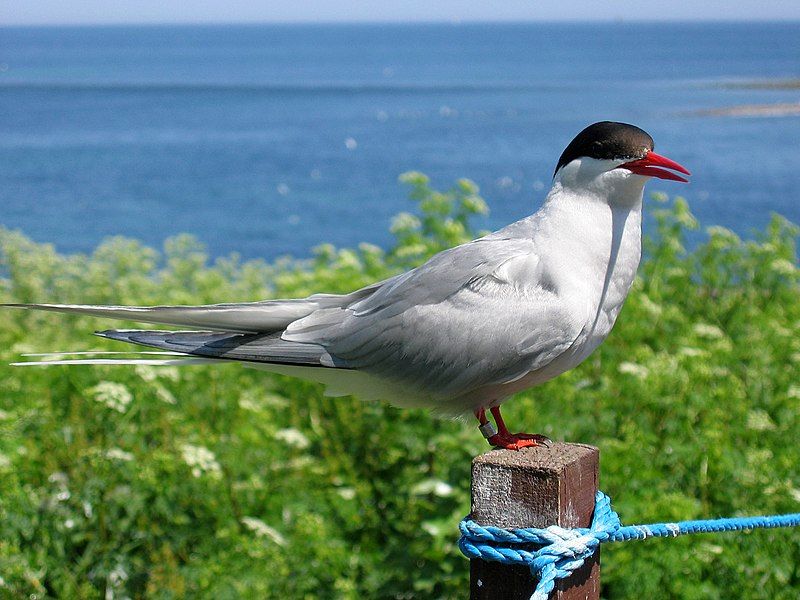
The Arctic tern is a species of seabird belonging to the family Laridae. This tern species has a circumpolar breeding distribution, meaning it breeds in the Arctic and sub-Arctic regions of Europe, Asia, and North America.
This means it can be found in all these areas during the breeding season and in other regions during the winter.
During the breeding season, the Arctic tern migrates long distances from the Arctic and sub-Arctic regions to the Southern Hemisphere to find food.
This bird species is well known for its long migrations, with some Arctic terns traveling as far as from the Arctic to the Antarctic and back each year. The Arctic tern is a small bird, measuring around 33 cm in length and having a wingspan of approximately 65 cm.
It is an agile flyer with a fast and direct flight pattern and can make sharp turns in flight. Its diet mainly consists of small fish, sand eels, and other marine invertebrates.
| Kingdom | Animalia |
| Phylum | Chordata |
| Class | Aves |
| Order | Charadriiformes |
| Family | Laridae |
| Genus | Sterna |
| Species | S. paradisaea |
16. Spotted Sandpiper
The spotted sandpiper is a small shorebird belonging to the genus Actitis alongside its sister species, the common sandpiper. These two species are geographically distinct and often found in different areas.
However, individual birds may stray from their usual habitat and settle with breeders of other species. As a result, hybridization may occur between the two species, where their genes are combined to form offspring of both species.
This hybridization may result in a new species or a different variation from the original species. Hybridization between the two species is common and can be a great source of genetic diversity.
| Kingdom | Animalia |
| Phylum | Chordata |
| Class | Aves |
| Order | Charadriiformes |
| Family | Scolopacidae |
| Genus | Actitis |
| Species | A. macularius |
17. Gulls
The Laridae family is a group of seabirds belonging to the order Charadriiformes and consists of approximately 100 species divided into 22 genera. Various names, such as gulls, terns, skimmers, and kittiwakes, know these birds.
They are an incredibly versatile species, capable of living in various habitats ranging from marine and coastal areas to inland wetlands.
Laridae birds are found on every continent except Antarctica and can be seen in various habitats, from shorelines to inland wetlands. They are adept at aerial and aquatic hunting and have developed multiple behaviors to find food.
This includes scavenging, raiding other bird colonies, and stealing food from human settlements. They can also use their beaks to pluck food from the water’s surface.
The adaptation of Laridae birds to their environment and widespread distribution make them a valuable part of the global ecosystem.
| Kingdom | Animalia |
| Phylum | Chordata |
| Class | Aves |
| Order | Charadriiformes |
| Family | Laridae |
18. Osprey
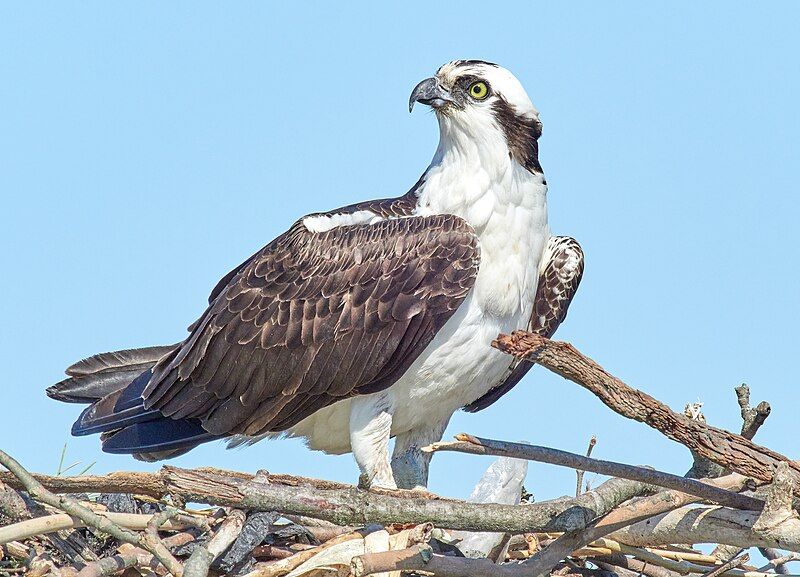
The Osprey is a unique bird of prey with many habitats. Its name is derived from two Latin words, “os” for “bone” and “pre” for “predator.” Many names, such as sea hawk, river hawk, and fish hawk, know this raptor species.
It is a diurnal bird that is active daily and feeds mainly on fish. The Osprey is a large bird, measuring more than 60 cm long and 180 cm across its wings. Its coloring is primarily brown on its upperparts and greyish on its head and underparts.
It has long, sharply pointed wings and a strong, hooked bill, which help it to capture its prey from the water.
Its feet are specially adapted for gripping slippery fish, and its talons are curved and robust to ensure a secure hold. The Osprey is a mighty and agile hunter, soaring above the water and diving to snatch up its prey in a spectacular display of aerial acrobatics.
It can have heavier prey than other birds of its size and is cablecar long distances in search of food. The Osprey is a wide-ranging species found on every continent except Antarctica.
It is a migratory species, moving to warmer climates in the winter months and returning to northern regions during the summer. It is an essential symbol of nature, with its majestic beauty and impressive hunting skills.
| Kingdom | Animalia |
| Phylum | Chordata |
| Class | Aves |
| Order | Accipitriformes |
| Family | Pandionidae |
| Genus | Pandion |
| Species | P. haliaetus |
19. Manx Shearwater
The Manx Shearwater is a species of seabird belonging to the Procellariidae family. The scientific name for the species has changed over time; in the 17th century, these birds were referred to as Manks Puffins.
‘Puffin’ combines two words, ‘Anglo-Norman’ and ‘cured carcasses.’ The first part, ‘Anglo-Norman,’ refers to the language of the Norman people.
The second part of the word, ‘cured carcasses,’ is related to preserving the corpses of the nestling shearwaters. This process involved salting and drying the bodies, which would be used as food.
This practice was common in the 17th century, so the Manx Shearwaters were named ‘Manks Puffins.’ However, the name has changed to ‘Manx Shearwaters,’ used today.
| Kingdom | Animalia |
| Phylum | Chordata |
| Class | Aves |
| Order | Procellariiformes |
| Family | Procellariidae |
| Genus | Puffinus |
| Species | P. puffinus |
20. Gannets
Gannets are a type of seabird that belong to the genus Morus in the Sulidae family, which is closely related to boobies. They are large birds, with white feathers covering most of their body and a distinctive yellow head.
The wings have black tips, and their long bills are well suited to fishing. Northern gannets are the largest seabirds in the North Atlantic, with a wingspan of up to two meters.
This impressive wingspan allows them to soar above the ocean, searching for fish they can catch and eat. Gannets often hunt in groups, taking advantage of their more significant numbers to scare away fish from the water’s surface.
They are powerful fliers, able to cover large distances quickly and dive into the water with precision. Gannets are a vital part of the marine ecosystem, as they help to control the population of certain fish species, ensuring that the ocean remains in balance.
| Kingdom | Animalia |
| Phylum | Chordata |
| Class | Aves |
| Order | Suliformes |
| Family | Sulidae |
| Genus | Morus |
21. Northern Storm Petrels
Northern storm petrels are seabirds belonging to the genus Hydrobates in the family Hydrobatidae, which is part of the order Procellariiformes.
This family of storm petrels was previously grouped with the austral storm petrels in the combined storm petrels, but more recent research has found that they are not closely related, and thus, they have been separated.
Northern storm petrels are also known as ‘sea swallows’ due to their slender, swallow-like bodies and wings, and they are distinguished by their small size and short, pointed wings. They have adapted to the marine environment and feed on small fish and invertebrates.
They are found in the Northern Hemisphere and can be seen in calmer coastal waters, on rocky shores, or even at sea. Their distinctive call is a sharp ‘tew,’ which can be heard when flying in large flocks.
Northern storm petrels are essential to their ecosystem, as they act as indicators of environmental health and help maintain marine life’s balance.
| Kingdom | Animalia |
| Phylum | Chordata |
| Class | Aves |
| Order | Procellariiformes |
| Family | Hydrobatidae |
| Genus | Hydrobates |
22. Pelican
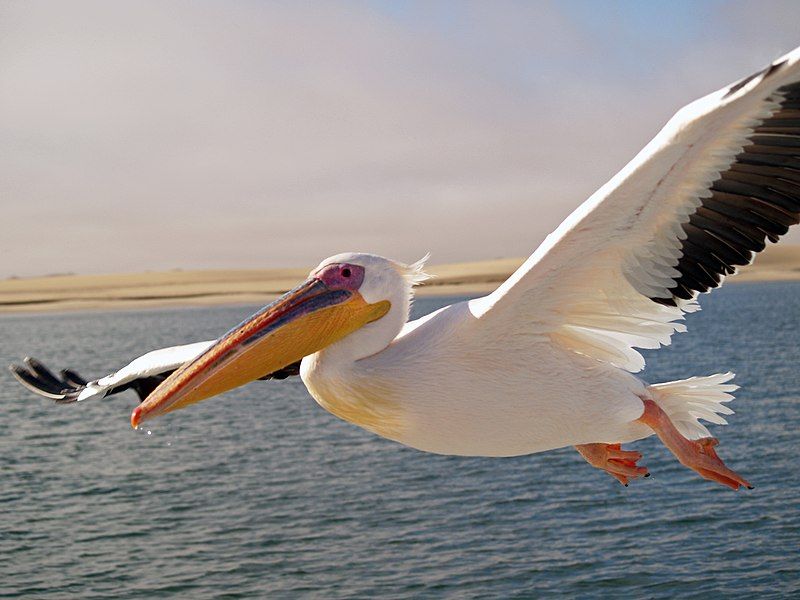
Pelicans are one of the world’s most recognizable species of water birds. They are a genus of large water birds that belong to the family Pelecanidae. Pelican species are distinguished by their long beaks and large throat pouch.
This pouch serves an essential purpose, as it is used for catching prey and draining the water from the contents before swallowing. Pelican plumage is mainly pale, although the brown and Peruvian species feature darker feathers.
They are also known for their large wingspan, allowing them to soar and glide easily over large bodies of water. Pelicans have a variety of ways to find food. They can dive deep into the water to catch fish or skim the surface for smaller prey.
They also use their beaks to scoop up food from the water. This is made possible by their large throat pouch, which expands to allow them to capture more significant amounts of food. Pelicans are also known for their social behavior.
They often form large colonies and are known to communicate with one another using a variety of vocalizations.
They are also known to travel in flocks. Overall, pelicans are fascinating creatures with unique characteristics that make them one of the most recognizable species of water birds.
Their ability to find food, large wingspan, and social behavior makes them an integral part of the aquatic ecosystem.
| Kingdom | Animalia |
| Phylum | Chordata |
| Class | Aves |
| Order | Pelecaniformes |
| Family | Pelecanidae |
| Genus | Pelecanus |
23. American Avocet
The American Avocet is a large shorebird belonging to the Recurvirostridae family, which includes avocets and stilts. It is native to North America and can be found in shallow waters or mud flats.
It feeds mainly on insects and crustaceans, which it finds by sweeping its bill from side to side in the water. This foraging method is known as ‘billing’ and is an expected behavior among wading birds.
The Avocet is also unique for its long, thin, upturned bill, perfectly adapted for its preferred foraging method. The American Avocet is a colorful and attractive bird, with a patch of black or dark brown feathers on its back and a white belly.
It is a graceful and elegant bird, often seen gracefully gliding across the water for its prey.
| Kingdom | Animalia |
| Phylum | Chordata |
| Class | Aves |
| Order | Charadriiformes |
| Family | Recurvirostridae |
| Genus | Recurvirostra |
| Species | R. americana |
24. Western Gull
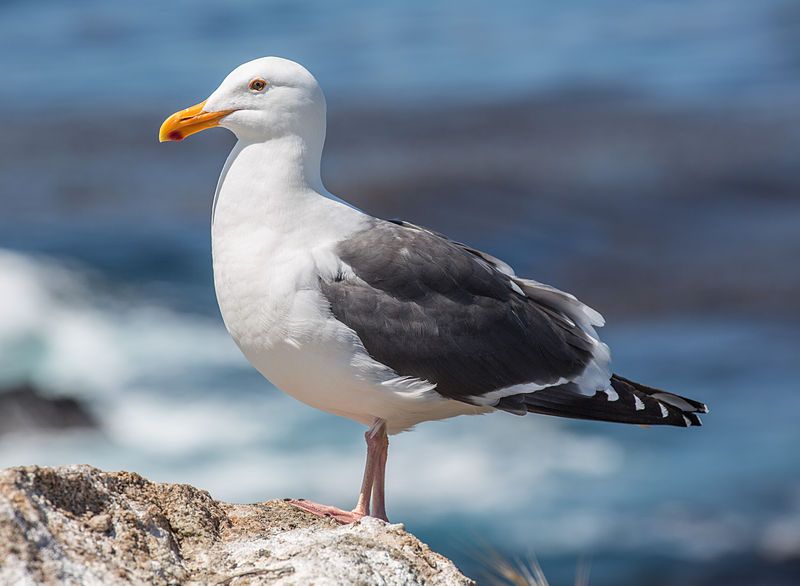
The western gull is a sizeable white-headed gull found along the west Coast of North America and the Pacific Ocean. Its range of habitation stretches from British Columbia in Canada to Baja California in Mexico.
It was previously classified as the same species as the yellow-footed gull in the Gulf of California. The western gull is a large bird with a wingspan of up to 1.85 meters.
Its plumage combines white on the head, neck, and underbody, grey on the back and wings, and black on the wings and tail. Its head is white, with a black eye ring and a yellow bill.
The legs and feet are yellow. The western gull is a social species, often seen in large numbers. It feeds on small fish, crustaceans, and insects, which it catches by diving or scavenging. It also usually follows fishing boats for scraps.
During breeding season, the western gull nests on coastal rocks, cliffs, and islands in the Pacific.
It lays two to three eggs incubated for about a month. The western gull was previously considered conspecific with the yellow-footed gull of the Gulf of California. However, recent studies have shown that they are genetically distinct and belong to separate species.
While the western gull is generally found on the Pacific coast, the yellow-footed gull is limited to the Gulf of California. The two species differ in size, with the yellow-footed gull slightly smaller than the western gull.
They also differ in coloration; the yellow-footed gull has more yellow on its plumage than the western gull.
| Kingdom | Animalia |
| Phylum | Chordata |
| Class | Aves |
| Order | Charadriiformes |
| Family | Laridae |
| Genus | Larus |
| Species | L. occidentalis |
25. Brandt’s Cormorant
Brandt’s cormorant is a type of seabird in the cormorant family that lives along the Pacific coast of North America. These birds can be found all along the Coast from Alaska to the Gulf of California during the summertime.
However, when winter comes, the population of Brandt’s cormorants north of Vancouver Island migrate south to warmer areas. This is likely due to the colder temperatures and reduced food sources in the north.
The birds will typically migrate back to their original locations when spring arrives. This behavior helps ensure the species’ survival and demonstrates their adaptability to the changing seasons.
| Kingdom | Animalia |
| Phylum | Chordata |
| Class | Aves |
| Order | Suliformes |
| Family | Phalacrocoracidae |
| Genus | Urile |
| Species | U. penicillatus |
26. Pelagic Cormorant
The pelagic cormorant is a bird species belonging to the Phalacrocoracidae family, otherwise known as cormorants. It is a relatively small species, measuring 54 and 66 cm in length, with a wingspan of up to 90 cm.
It is commonly referred to by several other names, including Baird’s cormorant and violet-green cormorant. Due to its small size, it is sometimes referred to as the pelagic shag. This bird species is typically found near the Coast, feeding mainly on fish.
It has a dark greenish-black plumage highlighted by a light violet sheen. Its head and neck are usually white, while its beak is grey. The pelagic cormorant is an essential species in the wild, as it helps maintain the balance of the marine ecosystem by preying on fish.
| Kingdom | Animalia |
| Phylum | Chordata |
| Class | Aves |
| Order | Suliformes |
| Family | Phalacrocoracidae |
| Genus | Urile |
| Species | U. pelagicus |
27. Rhinoceros Auklet
The rhinoceros auklet is a unique seabird that belongs to the same family as the puffins. It is the only known species of its genus, Cerorhinca, and is notable for its close resemblance to its cousins.
Owing to its distinct physical similarity to the puffins, people have even proposed to give the rhinoceros auklet the common name, rhinoceros puffin. The rhinoceros auklet is a small, black-and-white bird with a brownish-gray back.
It has a short, thick bill with a yellowish base and a black tip. Its distinguishing feature is the two small ‘horns’ above its eyes, giving it its unique name. These horns are feathers.
The rhinoceros auklet is typically found in the Northern Pacific Ocean, ranging from the Aleutian Islands to Baja California. It nests in burrows and feeds on small crustaceans and fish. Though it is closely related to puffins, it differs in behavior and diet.
The rhinoceros auklet is a rather solitary bird, while puffins form colonies. Additionally, while puffins feed on small mollusks, the rhinoceros auklet feeds on crustaceans and fish.
Overall, the rhinoceros auklet is an exciting bird species closely related to the puffins. Its similarities to its cousin have caused people to propose a common name, rhinoceros puffin.
As a species, it is fascinating in its own right and has a unique diet and behavior.
| Kingdom | Animalia |
| Phylum | Chordata |
| Class | Aves |
| Order | Charadriiformes |
| Family | Alcidae |
| Genus | Cerorhinca |
| Species | C. monocerata |
28. European Stonechat
The European stonechat is a small passerine bird, which means it belongs to the order of perching birds. It was previously classified as a subspecies of the common stonechat, a bird species native to Europe and parts of Asia.
For a long time, the European stonechat was considered a part of the thrush family, Turdidae. Still, recent genetic evidence has revealed that the European stonechat and its related species belong to the Old World flycatcher family, Muscicapidae.
This implies that the European stonechat is more closely related to Old World flycatchers than to thrushes. The discovery of this relationship is essential for understanding the evolution of birds in the Old World, as it provides insight into the relationship between species.
| Kingdom | Animalia |
| Phylum | Chordata |
| Class | Aves |
| Order | Passeriformes |
| Family | Muscicapidae |
| Genus | Saxicola |
| Species | S. rubicola |
29. Chough
The Corvidae family of birds is known for its colorful and intelligent members, and the two species of passerine birds known as choughs are no exception. Choughs belong to the genus Pyrrhocorax and consist of two distinct species: the red-billed chough and the Alpine chough.
The red-billed chough is slightly larger than its Alpine counterpart and is known for its rusty-red beak, legs, and black plumage. The Alpine chough, however, is smaller in size and has a distinctive yellow beak, white feathers, and black tail.
Both species of choughs are found in mountainous regions and prefer to forage in flocks. They are omnivorous birds and feed on various items, such as insects, grains, and fruits.
In addition, they are known to be quite vocal and can make various loud and distinctive calls. Choughs are also highly social birds and can form strong bonds with other flock members.
As a result, they are a fascinating and beloved bird species and are well-known for their intelligence and beauty.
| Kingdom | Animalia |
| Phylum | Chordata |
| Class | Aves |
| Order | Passeriformes |
| Family | Corvidae |
| Genus | Pyrrhocorax |
30. Marbled Godwit
The marbled godwit is a migratory shorebird species belonging to the family Scolopacidae. It is a large bird with an average length of around 50 cm and a wingspan of around 75 cm.
The marbled godwit is also the largest of the four species of godwit, the other three being the black-tailed, Hudsonian, and bar-tailed godwits.
The marbled godwit is found throughout much of North America, breeding in the northern part of the continent and migrating south in the winter months.
Its preferred habitats are wetlands, mudflats, and coastal areas, where it can feed on invertebrates such as worms, mollusks, and crustaceans. Its diet also includes some plant matter, such as seeds and berries.
During the breeding season, the marbled godwit forms pairs and nests on the ground in grassy areas near wetlands. The female lays 3-4 eggs, incubated by both parents for around three weeks before hatching.
The chicks will then remain with their parents until they fledge at around four weeks old.
| Kingdom | Animalia |
| Phylum | Chordata |
| Class | Aves |
| Order | Charadriiformes |
| Family | Scolopacidae |
| Genus | Limosa |
| Species | L. fedoa |
31. Semipalmated Plover
The semipalmated plover is a small shorebird belonging to the genus Charadrius. The genus Charadrius is derived from a Late Latin word meaning a yellowish bird, mentioned in the fourth-century Vulgate.
This word is derived from the Ancient Greek word kharadrios, a type of bird found in ravines and river valleys. The species name, semipalmatus, is derived from the Latin words semi, meaning “half,” and palma, meaning “palm.”
This likely refers to the semipalmated plover’s distinctive anatomy, which features partially webbed feet. This webbing is thought to help the bird to move around in wet and muddy habitats.
The semipalmated plover is a widespread species across North America, Europe, and Asia.
| Kingdom | Animalia |
| Phylum | Chordata |
| Class | Aves |
| Order | Charadriiformes |
| Family | Charadriidae |
| Genus | Charadrius |
| Species | C. semipalmatus |
32. Great Cormorant
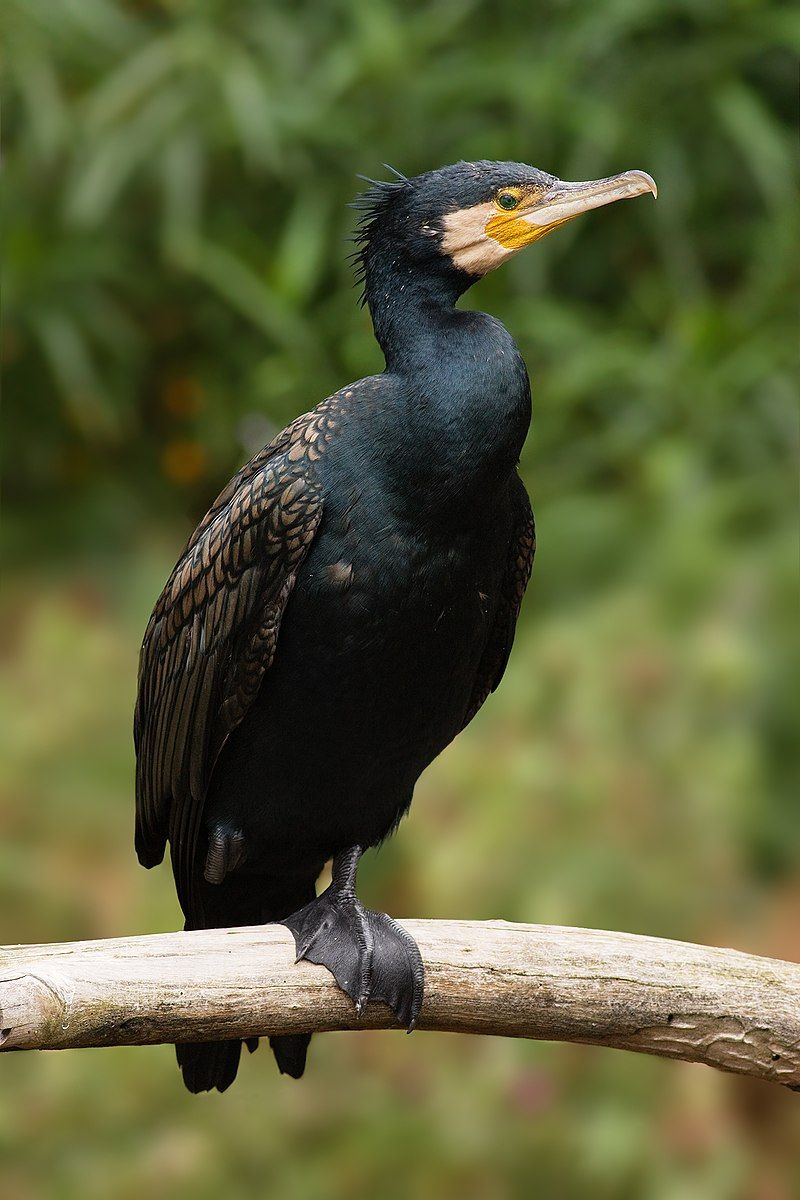
The great cormorant is a seabird species found across many world regions.
Many names, including the black shag or kawau in New Zealand, the great black cormorant in the Northern Hemisphere, the black cormorant in Australia, and the large cormorant in India know it.
This bird is a member of the cormorant family and is found near coasts and in inland waterways. The great cormorant is a large bird, typically measuring up to 38 inches long. It has black feathers over its entire body, with a white patch on its throat.
Its wings are long and narrow, and its tail is broad and forked. Its bill is long and sharp, and its feet are webbed, helping it to swim and catch fish. The great cormorant feeds mainly on fish, which it catches by diving into the water.
It can reach depths of up to 150 feet while hunting. It is also known to eat frogs, crustaceans, and small mammals. The great cormorant is a social bird, often found in large colonies or groups with other seabirds.
It nests mainly in trees and on cliffs, building nests of sticks, seaweed, and feathers. The female typically lays three to five eggs, which both parents take turns incubating. The great cormorant is an important species, serving as a top predator in its environment.
It helps to maintain a healthy balance of the fish population, as well as other species. As a result, it is an important species to protect and conserve.
| Kingdom | Animalia |
| Phylum | Chordata |
| Class | Aves |
| Order | Suliformes |
| Family | Phalacrocoracidae |
| Genus | Phalacrocorax |
| Species | P. carbo |
33. Eurasian Whimbrel
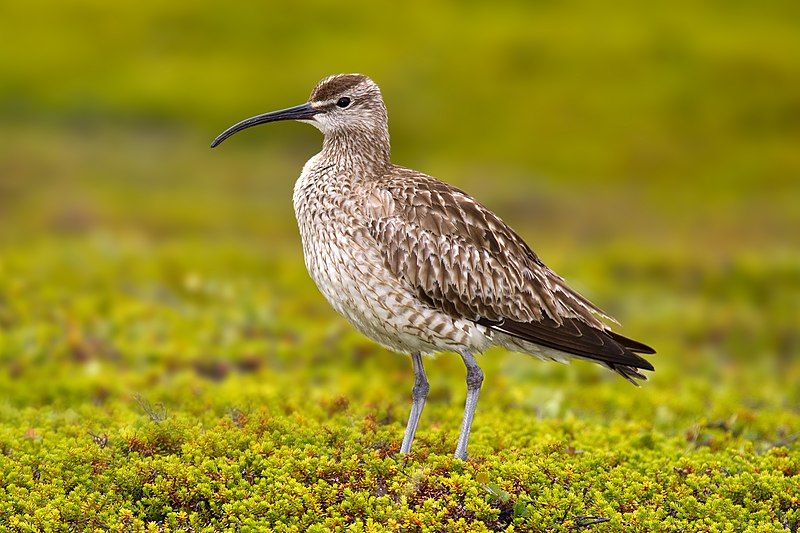
The Eurasian or common whimbrel is a type of water bird that belongs to the Scolopacidae family. It is widely distributed across much of subarctic Asia and Europe, ranging from the northern parts to Scotland in the south.
In North America, this species is known as the white-rumped whimbrel. The Eurasian or common whimbrel is one of the most abundant species of curlews, a group of birds that typically have a long, decurved bill and a large, rounded wingspan.
This species is highly adapted to its environment, possessing solid and powerful legs that enable it to travel long distances for food.
The Eurasian or common whimbrel is a migratory species, typically traveling south during winter to find more abundant food sources. It feeds primarily on insects, crustaceans, mollusks, and small vertebrates.
This species is also known for its distinctive call, a loud, high-pitched whistle that can be heard from quite a distance.
| Kingdom | Animalia |
| Phylum | Chordata |
| Class | Aves |
| Order | Charadriiformes |
| Family | Scolopacidae |
| Genus | Numenius |
| Species | N. phaeopus |
34. Greater Yellowlegs
The greater yellowlegs is a type of bird that belongs to a family of shorebirds known as Scolopacidae. It is a large bird found in many parts of North America. The greater yellowlegs breeds in the summertime in central Canada and southern Alaska.
During the winter, it migrates to regions in southern North America, Central America, the West Indies, and South America. This migration is a natural part of its life cycle that helps it survive and thrive in different regions to reproduce and find food sources.
When it is breeding, the greater yellowlegs can be found in shallow wetlands and muddy shorelines. These areas provide the bird with the best conditions for finding food and nesting.
During the winter, the bird can be found in more open habitats such as grasslands, marshes, and fields. The greater Yellowlegs are an essential part of the natural ecosystem of North America.
It is a vital part of the food chain, as it feeds on various insects, small crustaceans, and other invertebrates. It is also a famous bird for birdwatchers, as it can be observed in many habitats throughout its range.
| Kingdom | Animalia |
| Phylum | Chordata |
| Class | Aves |
| Order | Charadriiformes |
| Family | Scolopacidae |
| Genus | Tringa |
| Species | T. melanoleuca |
35. Tufted Puffin
The tufted puffin, also known as the crested puffin, is a medium-sized seabird that belongs to the auk family. It is widely distributed in the North Pacific Ocean and is one of three species of puffins that make up the genus Fratercula.
It is easily identifiable due to its thick red bill and yellow tufts. The tufted puffin is a relatively abundant species known for its diving capabilities.
It dives deep in search of fish, crustaceans, and mollusks, which it uses to feed itself and its young. The tufted puffin can also fly long distances and is known to migrate to warmer climates during the cooler months.
It is an essential species for the ecosystem, as it helps to maintain the balance of marine life in the North Pacific.
| Kingdom | Animalia |
| Phylum | Chordata |
| Class | Aves |
| Order | Charadriiformes |
| Family | Alcidae |
| Genus | Fratercula |
| Species | F. cirrhata |
36. Sharp-tailed Sandpiper
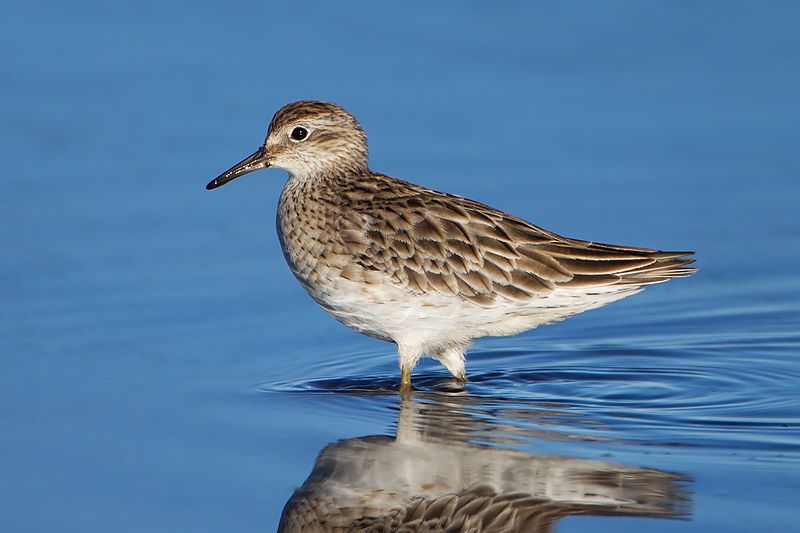
The sharp-tailed sandpiper is a small to medium-sized migratory shorebird, found mainly in Siberia for summer breeding and in Australia for its wintering season. This species can be identified by its long and slender bill and its short yellow legs.
Its greyish-brown upperparts are finely barred, and its underparts are white. It can be found in different wetlands during its migrating season, where it feeds on insects and crustaceans.
The sharp-tailed sandpiper is a common species; however, its population is declining due to the increasing pressure on its habitats. As such, conservation efforts are necessary to protect the species and its habitats.
| Kingdom | Animalia |
| Phylum | Chordata |
| Class | Aves |
| Order | Charadriiformes |
| Family | Scolopacidae |
| Genus | Calidris |
| Species | C. acuminata |
37. Lesser Yellowlegs
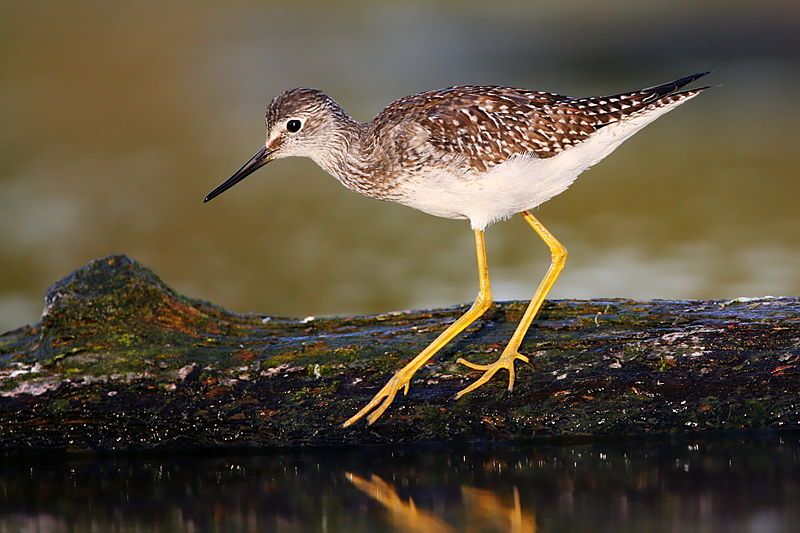
The lesser yellowlegs is a bird species that belongs to the shorebird family. It is considered medium size, with a length of around 25 cm and a wingspan of around 50 cm.
It is recognizable by its long, yellow legs, pale yellowish-gray upperparts, and white underparts. The lesser yellowleg is a migratory bird, breeding in the boreal forest region of North America.
This region stretches from Alaska to Newfoundland and Labrador and includes parts of the northern United States, including Minnesota, Wisconsin, and Michigan.
During the breeding season, it can be found in wetlands, bogs, and open woodlands, where it builds its nest on the ground. The female lays up to four eggs, which both parents incubate. Once the chicks hatch, the family will migrate south for the winter.
The lesser yellowlegs can be found in wetlands, ponds, marshes, and mudflats throughout the United States, Mexico, and Central America during this time. It feeds on various invertebrates, such as insects, crustaceans, and mollusks.
| Kingdom | Animalia |
| Phylum | Chordata |
| Class | Aves |
| Order | Charadriiformes |
| Family | Scolopacidae |
| Genus | Tringa |
| Species | T. flavipes |
38. Short-billed Dowitcher
The short-billed dowitcher is a species of shorebird belonging to the family Scolopacidae. It is a medium-sized bird with a stocky body and a long bill. This species is native to North America, Central America, the Caribbean, and northern South America.
It is closely related to the long-billed dowitcher, which is also a member of the Scolopacidae family. The short-billed dowitcher is a ground-dwelling bird found in wetland areas such as marshes, mudflats, and shallow ponds.
It feeds by probing the mud with its long bill, searching for small aquatic invertebrates and other food items. It also forages in shallow waters, wading in search of food.
Its diet consists primarily of insects, but it eats other small invertebrates, crustaceans, and mollusks. The short-billed dowitcher is an essential species in the food chain, as it is preyed upon by predators such as hawks, owls, and herons.
The species is also an important indicator of wetland health, as its presence in an area indicates that the environment is suitable for other species of wetland-dependent birds.
| Kingdom | Animalia |
| Phylum | Chordata |
| Class | Aves |
| Order | Charadriiformes |
| Family | Scolopacidae |
| Genus | Limnodromus |
| Species | L. griseus |
39. American Golden Plover
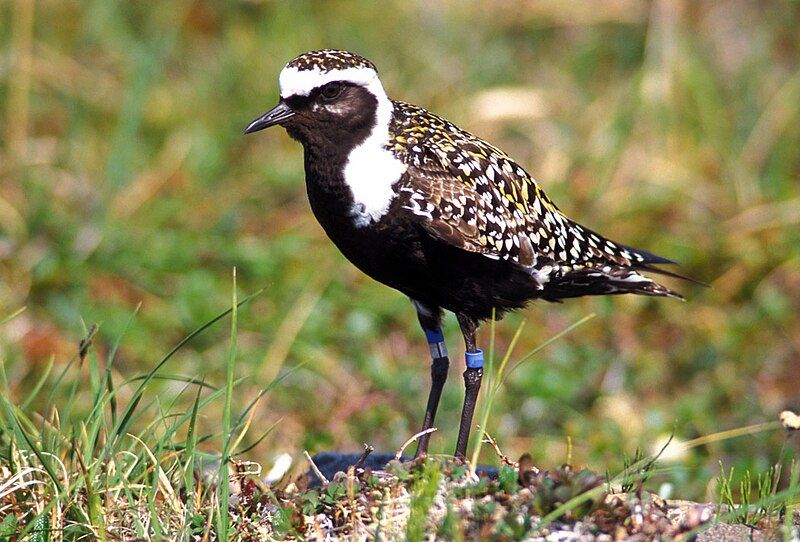
The American golden plover is a mid-sized bird of the plover family. Its scientific name, Pluvialis dominica, is derived from Latin and refers to rain. It is believed that when golden plovers flock together, rain is imminent.
The species name Dominica refers to the island of Hispaniola (formerly Santo Domingo) in the West Indies. The American golden plover is found throughout the Americas, from Canada and Alaska to northern South America.
It is a migratory bird, wintering in the southern United States, Mexico, and the Caribbean. The American golden plover is known for its golden-brown upperparts, white underparts, and black back.
It also has a black face with a white supercilium, or eyebrow, and a conspicuous white wing stripe. This stripe is more easily visible during the summer when the bird is in flight.
| Kingdom | Animalia |
| Phylum | Chordata |
| Class | Aves |
| Order | Charadriiformes |
| Family | Charadriidae |
| Genus | Pluvialis |
| Species | P. dominica |
40. Wandering Tattler
The Wandering Tattler is a wading bird that is medium in size. It has features similar to the closely related species, the Gray-tailed Tattler. Both species are found in coastal areas and muddy flats of the Pacific and Atlantic oceans.
The Wandering Tattler is generally brown on the upper side, while the Gray-tailed Tattler is gray. Both species have yellow legs and a yellowish or white eye-ring.
The Wandering Tattler is a migratory bird, spending the summer in the northern parts of the Pacific and Atlantic oceans and the winter in the southern parts. It feeds mainly on insects and crustaceans by wading in shallow water or picking them off the ground.
Its call is a loud, ringing “tak-tak-tak”. These two species are closely related, but their different behavior and habitat preferences can distinguish them.
The Wandering Tattler tends to stay in larger flocks and prefers to feed in shallow waters, while the Gray-tailed Tattler is often found alone and is more likely to feed on the shoreline.
| Kingdom | Animalia |
| Phylum | Chordata |
| Class | Aves |
| Order | Charadriiformes |
| Family | Scolopacidae |
| Genus | Tringa |
| Species | T. incana |
41. Albatrosses
Albatrosses are a species of large seabirds that belong to the biological family Diomedeidae. They are closely related to other species in the Procellariiformes order, such as storm petrels and diving petrels.
Albatrosses inhabit many habitats, including the Southern Ocean and the North Pacific. They are known for their impressive wingspan ranging from 2.1 to 3.6 meters and long-distance migratory patterns.
Albatrosses have a hooked bill that helps them catch prey like fish, squid, and crustaceans. They are also known to follow ships searching for food and are frequently seen soaring high above the ocean’s surface.
| Kingdom | Animalia |
| Phylum | Chordata |
| Class | Aves |
| Order | Procellariiformes |
| Family | Diomedeidae |
42. Long-billed Curlew
The long-billed curlew is a species of shorebird found in North America. It belongs to the family Scolopacidae and is also known as “sickle-bird” and “candlestick bird.”
This bird is found in central and western North America during the breeding season and migrates southward and towards the Coast during the winter. The long-billed curlew is a large bird with a distinctive long, down-curved bill.
It is usually grey-brown, with a white underside, and males and females have similar plumage. This species is generally seen in open grassy areas, mudflats, or wetlands.
It feeds mainly on insects and eats small aquatic creatures such as shrimp, crabs, and mollusks. During the breeding season, the long-billed curlew builds its nest in shallow depressions on the ground, often near water.
The female will lay three to four eggs in the nest, and both parents will take turns incubating them. The young curlews will fledge in around three weeks and can fly within a month.
| Kingdom | Animalia |
| Phylum | Chordata |
| Class | Aves |
| Order | Charadriiformes |
| Family | Scolopacidae |
| Genus | Numenius |
| Species | N. americanus |
43. Black-necked Stilt
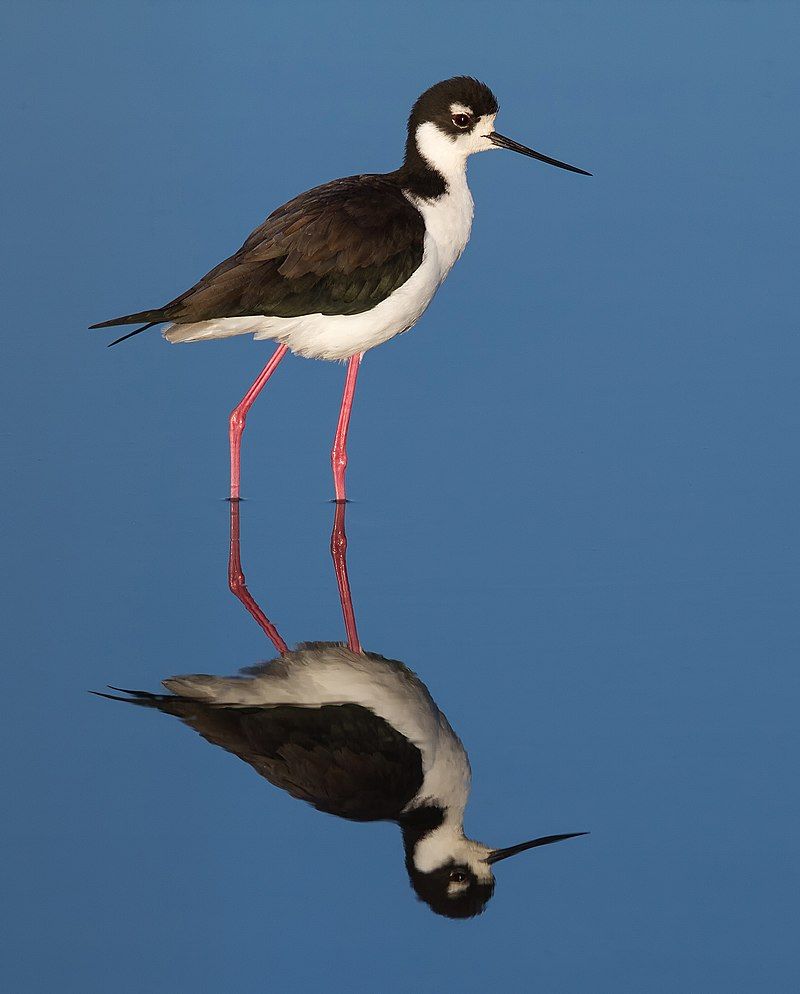
The black-necked stilt is a common shorebird species native to the United States. It can be found in the coastal areas of California and across much of the interior western United States.
It is also found along the Gulf Coast, from Texas to Florida, and along the East Coast, North Carolina to Massachusetts. The black-necked stilt is a long-legged wading bird, easily recognizable by its distinctive black neck and long, thin legs.
It is a reasonably large shorebird, measuring between 37 and 41 cm (14.5 and 16 in) in length. It has white plumage, black back, wings, and tail.
Its long, thin red bill is slightly upturned. The black-necked stilt is a gregarious bird, often seen in large flocks in its natural habitat. It prefers shallow, open wetlands like marshes, mud flats, flooded fields, and flooded meadows.
It feeds mainly on aquatic invertebrates, such as small crustaceans, insects, and mollusks. The black-necked stilt is an essential species in its native habitat.
It helps to maintain wetland environments and provide food for predators, such as hawks and raccoons. Unfortunately, its population is declining due to habitat loss, degradation, and human disturbance.
Conservation efforts are needed to help protect this species and its habitat.
| Kingdom | Animalia |
| Phylum | Chordata |
| Class | Aves |
| Order | Charadriiformes |
| Family | Recurvirostridae |
| Genus | Himantopus |
| Species | H. mexicanus |
44. Northern Fulmar
The northern fulmar is a species of seabird found primarily in the subarctic regions of the North Atlantic and North Pacific oceans. It is an abundant species characterized by its distinctive plumage, mainly white with black markings.
It has a long, narrow beak and a long tail. It is a strong flier and feeds mainly on small fish, crustaceans, and squid. Only one confirmed sighting of the northern fulmar in the Southern Hemisphere, with a single bird seen south of New Zealand.
This significant sighting shows that the northern fulmar can migrate over vast distances.
It is also a reminder that climate change affects the distribution of species, with species like the northern fulmar extending their range southward in response to changing temperatures.
The sighting also highlights the importance of continued research into the migration patterns of seabirds and the need for conservation efforts to protect these species and their habitats.
| Kingdom | Animalia |
| Phylum | Chordata |
| Class | Aves |
| Order | Procellariiformes |
| Family | Procellariidae |
| Genus | Fulmarus |
| Species | F. glacialis |
45. European Herring Gull
The European herring gull is a large bird, up to 66 cm long. It is a common sight in coastal regions of Western Europe, where it was once more plentiful.
It can be found breeding across Northern Europe, Western Europe, Central Europe, Eastern Europe, Scandinavia, and the Baltic states. It is a grey-backed, white-headed bird with long wings and a long, pointed bill.
Its plumage is a mix of white, grey, and black, and its wings are tipped in black. The European herring gull has a loud, repetitive call that can be heard from far away.
It is generally an adaptable species found in various habitats, from urban areas to open fields and even the sea. It is an omnivore, feeding on multiple items, including insects, carrion, fish, and garbage.
It is a social bird often seen on its breeding grounds in large flocks. These flocks are usually made up of individuals from multiple generations.
The European herring gull is a species of conservation concern, as its population has declined due to human activity and loss of habitat.
| Kingdom | Animalia |
| Phylum | Chordata |
| Class | Aves |
| Order | Charadriiformes |
| Family | Laridae |
| Genus | Larus |
| Species | L. argentatus |
46. Snowy Egret
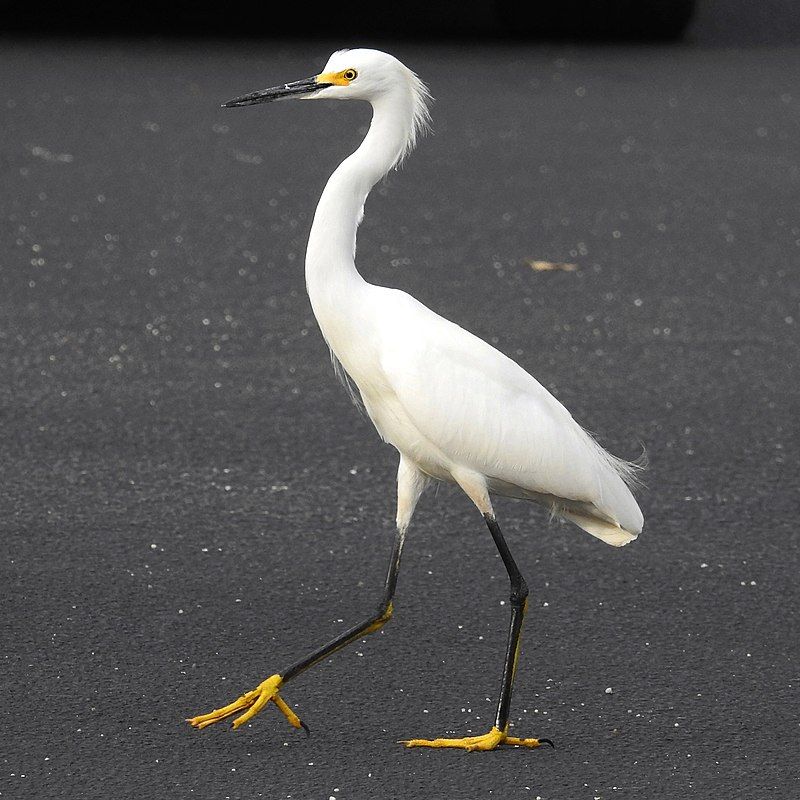
The snowy egret is a small white heron that belongs to the genus Ardea. Its name comes from Provençal French, aigrette, a diminutive of Aigron, meaning ‘heron.’ The species name thula is an error made by Chilean naturalist Juan Ignacio Molina in 1782.
He mistakenly attributed the name of the black-necked swan, the Araucano term, to the snowy egret. This mistake has since been corrected, but the species’ name remains. The snowy egret is found throughout much of North America, from Alaska to Central America.
They are typically found in wetlands, such as marshes, estuaries, and coastal areas. They feed on fish, insects, and crustaceans and can often be seen standing in shallow water, waiting for prey.
They have distinctive white plumage and long, black legs, and their yellow bill and feet give them a unique look.
| Kingdom | Animalia |
| Phylum | Chordata |
| Class | Aves |
| Order | Pelecaniformes |
| Family | Ardeidae |
| Genus | Egretta |
| Species | E. thula |
47. Buff-breasted Sandpiper
The buff-breasted sandpiper is a small shorebird belonging to the calidrid sandpiper family. It is native to North and South America and migrates during winter.
Its species name, subruficollis, is derived from the Latin words subrufus, meaning “reddish,” and Collis, meaning “-necked/-throated.” This refers to the bird’s reddish-brown neck and throat feathers. It is typically 15-17 cm long and has a 28-30 cm wingspan.
It has a distinctive white breast with a grayish-brown back and wings. The buff-breasted sandpiper has a unique courtship display involving a dance where the males will bow and flutter their wings.
They also have a loud, distinct call to communicate with other sandpipers. The buff-breasted sandpiper is a fascinating species that is an integral part of the ecosystem.
| Kingdom | Animalia |
| Phylum | Chordata |
| Class | Aves |
| Order | Charadriiformes |
| Family | Scolopacidae |
| Genus | Calidris |
| Species | C. subruficollis |
Conclusion
Exploring the coastal regions for birdwatching presents an exciting and diverse opportunity to encounter many avian species.
With 47 birds identified as particularly noteworthy in these areas, enthusiasts can immerse themselves in the beauty of coastal ecosystems while observing a wide range of feathered inhabitants.
Each species adds a unique charm to the coastal landscape, from majestic seabirds like gulls and terns soaring above the waves to elusive shorebirds darting along the shoreline.